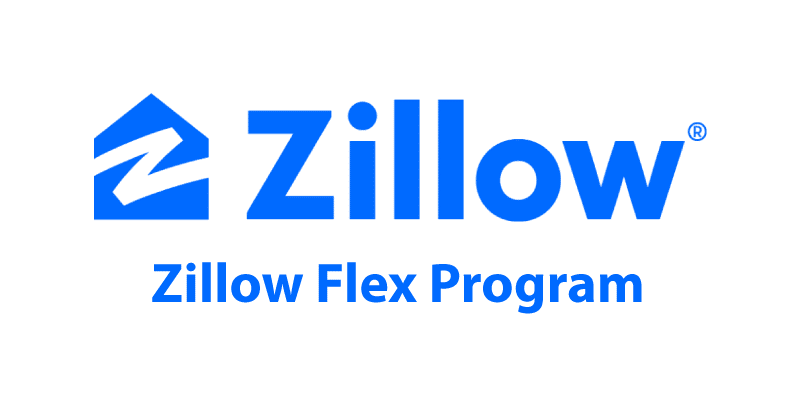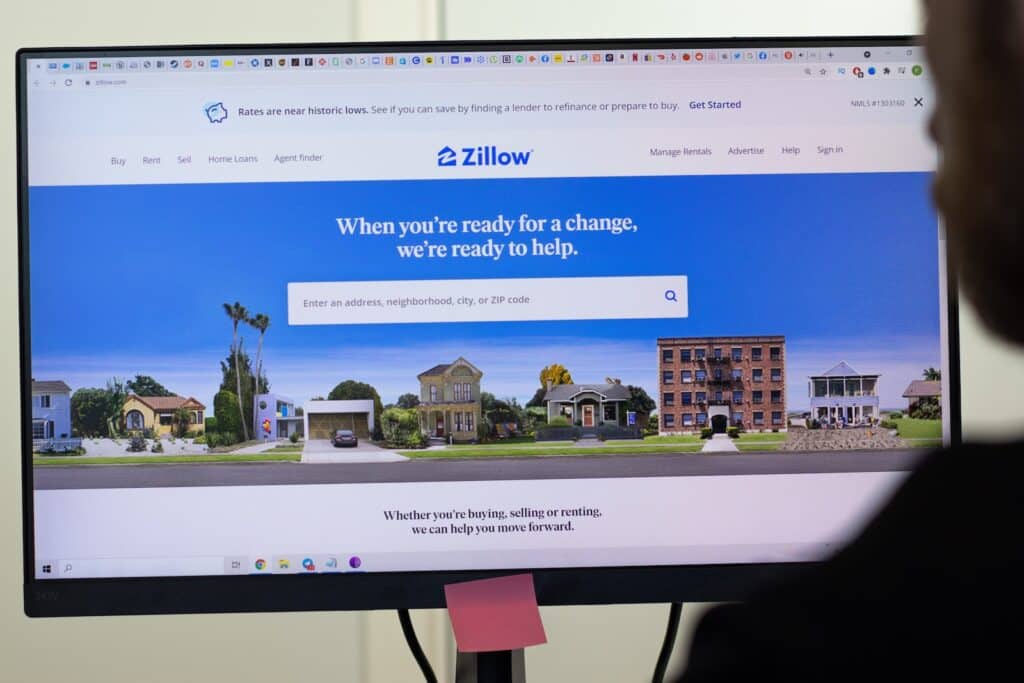What’s the deal with the Zillow Flex Program? Chances are, you’ve heard great things about this program. It’s known to be highly selective, but lucrative. Most agents or teams who participate find it well worth their time. So just how does one get into this exclusive club?
We’re breaking it all down in this article. Keep reading to learn the ins and outs of the Zillow Flex program.

What is Zillow Flex?
It’s a unique, invite-only lead generation platform specifically designed for real estate teams. Zillow launched Flex to create a system where agents can connect with high-quality leads without the initial financial burden of ad costs. Unlike their other offerings, Flex operates on a success fee model, meaning you’ll only pay when you close a deal.
More traditional models tend to involve upfront costs for leads, so this helps those just starting out or on a smaller budget to find opportunities for less investment. Agents who want to maximize their earning potential without a lot of ad spend could find it to be a game-changer. That being said, teams who participate must prove their close rates, so some success before joining the program is paramount.

How Does Zillow Flex Work?
You’re likely already somewhat familiar with Zillow and understand their large online presence. Right now, Zillow Flex is by invitation only (more on that below).
Here’s how the magic of Flex happens: Zillow generates leads through its substantial online platform, and when a potential client shows interest, those leads are distributed to agents in the Flex program.
Agents then connect with these clients, often through Zillow’s platform, which is meant to streamline communication. Zillow takes a hands-on approach in lead management, ensuring that agents are supported as they navigate those client connections. Then, Zillow gets a percentage of any deals that are closed.
Who is Eligible?
There is a bit of a catch with Zillow Flex: as of now, it’s an invitation-only program. Zillow has specific criteria for selecting agents and teams, focusing on those who have demonstrated success in their markets. If you’re preparing to apply, our guide on getting invited to zillow flex covers the exact requirements and step-by-step process to help you qualify.
If you’re interested in getting in on the action, you’ll need to show that you’re a top performer in your area. Expressing interest can be as easy as reaching out through Zillow’s platform and showcasing your experience. Then talk to them about what you’d need to do to become part of the program.
How is Zillow Flex Different From Their Premier Agent Program?
Zillow flex and Zillow Premier platforms can be helpful for agents looking to grow their business. That said, Flex operates on a success fee basis, while Premier Agents typically pay upfront for advertising. In other words, Flex is a pay-for-performance model, while Premier Agent requires some initial investments.
Flex’s lead validation and assignment process is also more streamlined, ensuring that agents receive leads that are more likely to convert. Plus, Flex has different engagement requirements, meaning agents must proactively follow up with leads. It’s also worth noting that Zillow Flex relies heavily on AI tools to qualify leads, while Zillow Premier offers a more hands-on approach to lead generation (which agents may or may not prefer).
The Investment: Pricing and Referral Fees
Let’s talk dollars and cents. According to Zillow, they will take a percentage of each sale or purchase completed using a Zillow connection. Their pricing webpage states: “The referral for each transaction is determined by (1) the location of the property and (2) the purchase or sale price of the property. The referral fee may vary by each Premier Agent Flex market.”
The typical referral fee for Zillow Flex pricing hovers between 20% to 40% of the commission earned on a closed deal. This success fee model is a departure from the traditional upfront ad spend, making it more appealing for many agents. However, keep in mind that these fees can vary based on the market, and many agents consider them quite hefty. You can gain more insight into their pricing rate cards here.
Performance Standards and Metrics
Recall that we mentioned the program is invite-only. Zillow’s goal is to include proven, high-performing agents who are most likely to close deals.
Because of that, there are strict Zillow Flex program requirements. They look at various performance metrics, including conversion rates and lead responsiveness. If you don’t meet these standards, you could face consequences, which might affect your eligibility in the program. Staying on top of your game is crucial!
Specific Metrics Tracked
The KPIs that Zillow will monitor for agents include*:
- 100% or greater % to Logged Transaction Target over the last 6 months.
- 15% Engaged Transfer Rate for three months, including an additional month of buffer to allow leads to mature.
- Your Zillow Home Loans Contact Rate must be at least 60% over a 3-month timeframe for your Flex team to be eligible for connection volume growth.
- 60% or greater Answer Rate over the last three months.
- 100% Pay on Time Rate over the last 3 months.
- 100% Closing Doc Submission Rate over the last three months.
*From the Zillow Flex website.
The Pros and Cons of Zillow Flex
Like anything else, Zillow Flex has its good, bad, and ugly. On the plus side, there are no upfront costs, you get access to high-quality Zillow Flex leads, and billing is simplified. However, those referral fees can be steep, and there’s a dependency on Zillow that some agents might find limiting. Plus, it’s highly competitive, so you’ll need to bring your A-game. Here’s a better breakdown.

Advantages:
- No Upfront Costs: The biggest draw is that agents don’t pay until they close a deal, reducing financial risk.
- High-Quality Leads: Access to leads more likely to convert, thanks to Zillow’s extensive reach, marketing efforts, and AI advancements.
- Simplified Billing: The success fee model makes financial planning easier and more predictable, as costs are directly tied to performance.
- Support from Zillow: Agents receive assistance in managing leads and connections, which can enhance client interactions.
- Flexibility in Marketing: Agents can diversify their promotional efforts since they’re not spending as much for leads.
Potential Disadvantages:
- High Referral Fees: The success fees, typically 20%-40%, can significantly reduce commission earnings per transaction.
- Dependency on Zillow: Agents may feel reliant on Zillow for leads, and it’s never a great idea to put all of your proverbial eggs in one basket.
- Competitive Environment: There’s a lot of competition among agents for leads–and remember, you’ll be competing against those who already perform well in the market.
- Performance Standards: As if real estate isn’t a high-pressure industry already, agents could feel increased stress about the Zillow Flex program requirements.
- Stricter Contract: The Flex program locks agents in for a minimum of one year, which is more than many lead-generation services out there.
Getting the Most Out of the Flex Program
Want to succeed in Flex? Here are a few tips from the experts. The bulk of them come down to general real estate best practices that can help any agent to be successful.
- Prompt Follow-Up: As with most real estate connections, you’ll want to respond to leads as quickly as possible to increase the chances of conversion; aim for initial contact within minutes rather than hours.
- Utilize Zillow’s CRM: Take full advantage of the customer relationship management tools provided by Zillow to track interactions, schedule follow-ups, and manage client relationships effectively.
- Personalize Communication: Customize your messages to leads based on their specific needs and interests, making your outreach feel more genuine and relevant.
- Set Up Alerts: Use Zillow’s notification features to stay updated on lead activity and market changes, ensuring you’re always informed and ready to act.
- Regularly Review Your Metrics: Monitor your performance metrics, such as conversion rates and response times, to identify areas for improvement and ensure you are meeting the Flex program requirements.
- Offer Value: Whenever possible, provide leads with valuable information, such as market insights, neighborhood guides, or home-buying tips, to establish yourself as a knowledgeable resource.
- Get Social Proof: Share testimonials or success stories from past clients in your communications to build trust and credibility with new leads.
Overall Impact: Zillow Flex and the Real Estate Industry
Some industry thought leaders will tell you that Zillow Flex is shaking things up in the real estate world. It challenges traditional brokerages by giving agents more control over their leads and marketing strategies. This shift could help to change the way agents operate, as they adapt to a more digital and competitive landscape.
On the other hand, Zillow Flex program reviews are mixed. Zillow is already a huge player in the real estate market, and this new platform consolidates their influence even more. It seems like Zillow is constantly looking for ways to bring more agents into their ecosystem, and this certainly accomplishes that.
Only time will tell what the ultimate impact will be, but for now, Flex seems to provide new opportunities to agents willing to demonstrate success.

Alternatives to Zillow Flex
If Zillow Flex isn’t your cup of tea–but you do want some help with leads–there are other options out there. Below are the top Zillow Flex alternatives:
- Rocket Homes: An offshoot of Rocket Mortgage, the program matches agents with prequalified buyers in the area. Users enjoy high-quality leads and transparent dashboards, but they must maintain a 4.5-star rating on the platform or lose eligibility.
- UpNest (by Realtor.com): More of a partnership model, the company offers robust tools and resources to help you bring prospects to the closing table. There is an excellent app with lots of resources available, but you can expect 3-5 agents to compete for each lead.
- Sold.com: Free to join with a simple sign-up process, users can purchase additional placement on Sold.com with the Guaranteed Display program. Performance is rewarded (so the more leads you work, the more you’ll get), but sometimes the leads referred to agents are a long way out from converting.
- Market VIP (by Realtor.com): This program promises a specially reserved pool of serious buyers. Agents are also able to keep leads exclusive for months, and there are a variety of digital tools that teams can rely on.
Zillow Flex Cost-Benefit Considerations
We’ve covered a lot of ground regarding why Zillow Flex is awesome. However, when searching real agent reviews, we encountered some hurdles. It’s important to note these potential pitfalls when determining if Flex is a fit for you.
- Trouble managing cash-flow effectively. If you or your team is not the most organized or dedicated to financial planning, some agents say dealing with the success fee model can be hard. Namely, when looking at cash flow, it’s important to remember how much will be going to Zillow once transactions complete.
- High competition in certain areas. Zillow hands out leads; some areas may have more or less than others. Furthermore, the agents in the program are all great sellers. You should figure that other agents may get the same lead, and they are likely equally qualified.
The biggest issue mentioned is the high referral fee. Most reviews pointed to a roughly 35% fee for transactions. As noted, this is variable, but we will use 35% as a benchmark. If you receive a lead for a $300,000 home, your commission will be around $18,000. That means you’ll pay Zillow approximately $6,300 (at 35%). According to NAR, the average timeline for closing a real estate deal is 86 days. So, you’ll spend about 3 months closing the deal, and then pay Zillow $6,300. Only you can determine if that investment makes sense based on your typical pipeline. Many teams end up feeling this is too steep.
The Zillow Flex Program offers a unique opportunity for agents to streamline their lead generation efforts without upfront costs. If you’re a motivated agent who can meet high performance standards, then you can assume the benefits you get will outweigh the potential drawbacks.
On the other hand, if you’re a new agent or still unproven, it may be hard to break into the program–and harder to keep up with the competition. Do your research and crunch the numbers, read some real-agent Zillow Flex program reviews, and then determine if this new platform is your big ticket to sales or just a waste of valuable time.


